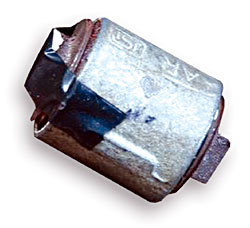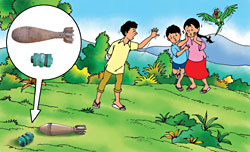|
|
| 'COLLATERAL DAMAGE': The remains of the bus in Madi in Chitwan that was blown up by a bucket bomb explosion triggered by the Maoists in June 2005. Forty passengers were killed and 70 injured. |
A growing number of victims are women and children who come across improvised explosive devices left by Maoists in fields, homes and trails across Nepal.
"It is possible that Nepal will be ranked among the top 10 countries in the world as a country affected with new civilian casualties due to victim-activated explosions," says mine and bomb risk expert Hugues Laurenge who is working with UNICEF in Nepal to raise awareness about the issue.
Nepal already has the world's second highest rate of children killed or injured due to explosive devices. Figures show the casualties among children in the country is much worse than even Afghanistan, Chechnya, Bosnia and Burundi. Of the total number of people killed by victim-activated explosions in 2005, more than half were children.
However, these have often been misinterpreted by the media, human rights activists, UN personnel and security forces and other individuals. The issue of landmines has been often exaggerated with rumours, the most popular being that they are planted in the villages controlled by Maoists.
The only anti-personnel mines in Nepal are those planted by the security force to protect their own barracks, police posts, airports and government office premises. When haphazardly positioned without warning signs, they can cause civilian casualties.
Last September, two women in Manthali in Ramechhap were injured while trying to cut grass by inserting their hands inside a secured fence of the army camp. The anti-personnel landmine exploded. Fortunately, both survived. There have been cases of soldiers wounded after stepping on landmines within military bases.  However, it isn't the army's landmines but the Improvised Explosive Devices (IED) used predominantly by the Maoists that have been responsible for the killing of most civilians. These include socket bombs, booby traps, pressure cooker bombs, pipe bombs and bucket bombs. Most socket bombs are homemade and easily manufactured with the help of 70-80 grams of commercial explosives and dynamites available in India. Recent hauls of explosives and detonators in Morang and Bhairawa show the rebels are bringing huge quantities of explosives into the country.
However, it isn't the army's landmines but the Improvised Explosive Devices (IED) used predominantly by the Maoists that have been responsible for the killing of most civilians. These include socket bombs, booby traps, pressure cooker bombs, pipe bombs and bucket bombs. Most socket bombs are homemade and easily manufactured with the help of 70-80 grams of commercial explosives and dynamites available in India. Recent hauls of explosives and detonators in Morang and Bhairawa show the rebels are bringing huge quantities of explosives into the country.
One of the deadliest events was the detonation of a bucket bomb under a passenger bus in Madi, Chitwan last June in which 40 passengers were killed and 70 injured. This wasn't a landmine or anti-vehicle mine but a home-made IED.
"This is a new problem as we see it, very violent and unexpected and the size of the trauma cannot be measured," warned Laurenge.
The number of deaths from explosives may seem small but it carries a disproportionate share of civilian casualties. In 2005 alone, the number of new casualties among civilians due to victim-activated explosions was 142 in 29 districts compared to only 58 among Maoists and security forces. The civilians were injured or killed when they unintentionally activated the explosive devices or were standing close to someone who did.
"There is a strong need to raise awareness on how one can avoid casualties when there is the opportunity to do so," explains Laurenge. The rules are simple:
. Avoid areas where clashes recently took place as there will always be stray socket bombs lying everywhere
. Do not touch roadblocks or unattended bags and don't stay close to military convoys
. Teach children what socket bombs, pressure cooker bombs and pipe bombs look like and warn them
|
|
| Phul Kaji Pradhan, 14, (with his mother in hospital) was playing near a road when a pressure cooker bomb used by the Maoists for the Panauti attack last month exploded. |
Educating civilians about the dangers of explosions has become more urgent with the Maoists on a blockade campaign along the highways. Maoist flags, banners and the king's effigies are often booby trapped. Security forces trying to remove these objects have often become victims of blasts.
Even bodies of combatants after a battle can be booby trapped or bombs in their possession can go off during removal. A dead soldier's booby-trapped body blew up during cremation at Pashupati last year injuring several people.
Then there are the unexploded ordinances (UXOs) which are becoming a major hazard as Maoist and RNA weaponry becomes more sophisticated. The army is frequently dropping mortar rounds and drums filled with explosives ('Tora Bora') from helicopters on Maoist positions, if they don't explode on impact for some reason they could kill civilians later.
Many battlefields are also littered with socket and pressure cooker bombs. A large number of child casualties in the past years have been due to children playing with UXOs, women touching them while collecting firewood.
"It can be deduced that the conflict, through the presence of explosive devices, has generated new risks for children in their immediate vicinities, sometimes in their own houses," explains Laurenge.
While combatants should be required not to leave behind explosives, the only thing that will save the children is if they know the dangers lurking around their homes, schools and playgrounds. It's time to take bomb-risk education seriously.
KNOW YOUR BOMBS  PIPE BOMB
PIPE BOMB
A simple improvised explosive device which is a pipe filled with an explosive material. The pressure of the burning explosive material ruptures the pipe resulting in a sudden, explosive release. The rupturing pipe creates metal fragments, which can cause injury.
UNICEF is using its famous Meena cartoon character to spread awareness among Nepali children about socket bombs and mortars (see pic).
The metal pipe is closed at both ends with steel or brass caps containing the filler. A fuse is inserted into the pipe with a lead running out through a hole in the side or capped end of the pipe. The fuse can be electronic with wires leading to a timer and battery or can be a common wick used in most consumer fireworks.
LAND MINE
This is a self-contained explosive device which is placed onto or into the ground, exploding when triggered by a vehicle or person. The name originates from the practice of sapping, where tunnels were dug under opposing forces or fortifications and filled with explosives. Land mines (euphemistically called 'area denial munitions') are used to restrict enemy movement in times of war. Tactically they serve a purpose similar to barbed wire channelling the movement of attacking troops in ways that permit the defenders to engage them more easily. From a military perspective, land mines serve as force multipliers, allowing an organised force to overcome a larger enemy.
Anti-personnel land mines or APLs are widely considered to be ethically problematic weapons because their victims are commonly civilians, who are often killed or maimed long after a war has ended. Removal of landmines is dangerous, slow and costly. However, some countries maintain that land mines are necessary to protect their soldiers in times of war.
BOOBY TRAPS
This is an antipersonnel device, such as a landmine or grenade, placed in building or in a noncombat area that has a psychological draw for enemy soldiers. The term comes from the implication such a trap will be set off by a foolish person (a booby). A booby trap is distinguished from a land mine by the fact that it is an improvised weapon, perhaps made from an artillery shell or a grenade or a quantity of high explosives, whereas a land mine is manufactured for its specific purpose. A booby trap may be buried in the manner common with land mines or not, though as a rule it is concealed in some fashion and set to be detonated by means of pressure or a trip wire.




